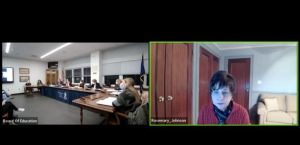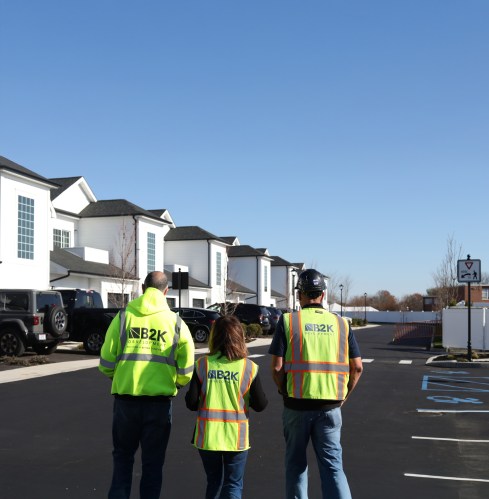
This year’s budget vote will be held on Tuesday, May 17, from 7 a.m. to 9 p.m. in the High School Gym. Voter information can be found on the district’s website, www.manhassetschools.org.
New York State aid for the Manhasset School District for the next school year will increase by $652,403 to $5,584,178, or 13.23 percent. It was part of a record amount of school aid provided by the state in its 2023 budget.
But that 13 percent hides a minor bump that caused Acting Superintendent Gaurav Passi and Deputy Superintendent for Business and Operations Rosemary Johnson to do some cost-cutting juggling. At first glance, $238,000 may seem like the proverbial “rounding error” in a 2022-23 school budget of $104.596 million. But that figure represented the decrease in state aid between the governor’s preliminary budget proposal and the adapted state budget for the 2023 state fiscal year, which began April 1. The school’s fiscal years begins July 1.
The Manhasset School District Board of Education adopted the 2022-23 budget at the April 13 meeting.
Per the state-mandated tax cap, the tax levy for the upcoming year is 2.38 percent.
It took a bit of work to reach the final budget figure. Though property taxes make up 90 percent of the district’s revenues, state aid—about 5 percent of the budget pie for Manhasset—can also be a factor.
“We fine tune the budget each year from the preliminary budget presentation through the budget adoption as incremental information continues to develop,” Passi observed.
For decades, school district administrators were bedeviled by the New York State government’s dysfunction, with late adopted state budgets creating much uncertainty for school district budget planners. There is another factor at play. Preliminary school budgets take their early cues from the governor’s budget proposal in January. By the time the governor and state legislature reached agreement on the final spending plan on April 9, Manhasset’s preliminary state aid figure decreased by that $238,000.
“And as a result we are required to reduce the budget buy a like amount,” Passi told attendees at the April 13 meeting as he talked over a slide titled, “How did we adjust the budget to reflect the reduction of $238,000 in state aid?”
One considerable cost is busing special education students to out-of-district facilities. The district saved money by reducing the number from 32 in a preliminary budget to 31 in the final one.

According to Passi, a more surprising savings came from lowering its estimated health insurance premiums. Because districts start their fiscal years on July 1 while insurance premiums are based on calendar years, districts can sometimes face unexpected costs midway through the school year.
“We also adjusted the budget to reduce the assumed increase in health insurance premiums for 22-23,” Passi stated. “We have revised the assumed increases from 7.5 percent to 6.25 percent based on a 10-year trend analysis. We are comfortable with this revision, although you heard me saying in previous presentations that it’s always a challenge when you’re operating in a tax cap environment.”
Board Vice President Christine Monterosso asked, “Can you explain why you’re confident of the adjustments on the health insurance premiums? Why you’re able to feel confident that we could go down to 6.25 percent?”
Johnson said she went back 10 years and looked at the actual increases year-over-year and studied where the district had spikes in insurance premiums.
“We had a very significant spike this year as you know, a 12.7 percent increase in health insurance premiums for 2022,” Johnson observed. “Analysis shows that in the year following that kind of significant increase we tend to see more of a drop-off. And so I felt comfortable bringing the number down to 6.25 percent [based on] that 10-year look back. Obviously, there’s been some significant volatility.”
Board President Pat Aiken wanted to know how much money the drop in premiums would save the district, and Johnson answered, “About $85,000,” calling the other savings in the budget “minor stuff.”
Passi asked Johnson to explain the state aid “glitch” when compared to other districts.
Johnson replied, “We have to separate out what happened in the governor’s [proposed budget] when many districts received significant increases in state aid, but we did not. That is based on how districts have received Foundation Aid over an extended period of time. Districts were shorted under the allocation of Foundation Aid and were for a long period of time. Ours was not. And we don’t rely so much on Foundation Aid because it is a wealth-driven aid and therefore we get less.”
By comparison, “high-need” districts like Westbury, Hempstead and even Levittown got many tens of millions in state aid.
The state is in the second year of a three-year plan agreed to last spring to fully fund school districts in compliance with a court ruling in the 2000s that found that the state was violating students’ right to a “sound basic education.” Foundation Aid was created in 2007 following the court cases, but the state has been locked in litigation and has never fully funded Foundation Aid until the agreement was reached last year.
At the April 7 presentation, Passi put up a graph showing the tax levy and budget percentage increases going back to the 2009-2010 budget.

“It’s important to note that the historic tax levy and budget increases over the last 14 years show that the average to average levy increase is 2.01 percent. And what this signifies is that the district has adopted a tax cap mentality in 2009-10, long before the tax cap was adopted and stayed true to that, which has the impact of making our budgets very lean. And as I said as at our last presentation. not only are up budgets very lean but we’re also very careful about every dollar that we spend.”
Behind The Numbers
In his presentations, Passi said the budget was built on the following guiding ideas:
• Designed to support a climate of innovation and collaborative learning, in an environment that encircles students in a culture of care.
• Ensures that each student experiences a curriculum that is rigorous, engaging, and consistent by aligning professional practice across grade levels and content area teams.
• Supports a culture of high expectations, opportunities, and supports where we endeavor to turn gates into stepping stones for each student.
• Is fiscally responsible and reflects a return to pre pandemic operations within the allowable tax cap.
• Supports the development of teh whole child with academics, athletics and extra-curricular activities, artistic pursuits and social and emotional wellness.
The budget, Passi went on, builds on a strong foundation of innovative programming and last year’s budget financed reading and math specialists as well as IT technicians.
“In the secondary school it’s worth noting that the Project Lead the Way engineering program is fully implemented, including a full sequence of engineering courses,” Passi said. “And the budget supports the adoption of new secondary school courses and instructional technology upgrades throughout the district.”
He added, “In last year’s budget we were able to add new staffing to support our students’ experiences. Each of those staffing petitions have continued in this year’s budget. This budget continues to provide long-term Investments in improving our facilities and we’ve spoken about how important that investment has been.”
By The Numbers
2022-2023 Budget: $104,596,692
2021-2022 Budget: $102,320,176
Increase: $2,276,786
Percent Increase: 2.23 percent
2022-2023 Tax Levy: $94,341,648
2021-2022 Tax Levy: $92,147,707
Proposed Tax Levy Increase: 2.38 percent
Allowable Tax Levy Increase: 2.38 percent




























